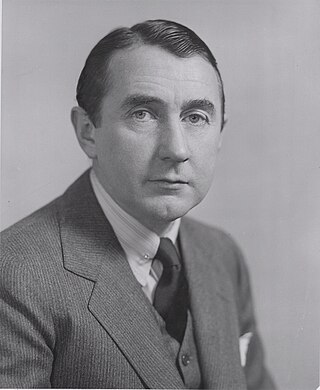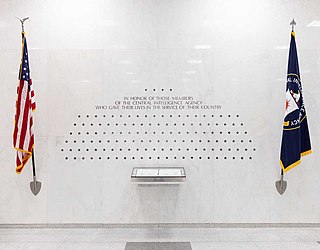Related Research Articles

The National Security Act of 1947 was a law enacting major restructuring of the United States government's military and intelligence agencies following World War II. The majority of the provisions of the act took effect on September 18, 1947, the day after the Senate confirmed James Forrestal as the first secretary of defense.

Roscoe Henry Hillenkoetter was the third director of the post–World War II United States Central Intelligence Group (CIG), the third Director of Central Intelligence (DCI), and the first director of the Central Intelligence Agency created by the National Security Act of 1947. He served as DCI and director of the CIG and the CIA from May 1, 1947, to October 7, 1950, and, after his retirement from the United States Navy, was a member of the board of governors of National Investigations Committee On Aerial Phenomena (NICAP) from 1957 to 1962.

The director of central intelligence (DCI) was the head of the American Central Intelligence Agency from 1946 to 2004, acting as the principal intelligence advisor to the president of the United States and the United States National Security Council, as well as the coordinator of intelligence activities among and between the various US intelligence agencies.

Sidney William Souers was an American military intelligence officer who was the first person to hold the office of Director of Central Intelligence, being head of the National Intelligence Authority, the direct predecessor to the Central Intelligence Agency.

William Harding Jackson was a U.S. civilian administrator, New York lawyer, and investment banker who served as Deputy Director of the Central Intelligence Agency. Jackson also served briefly under President Dwight D. Eisenhower as Acting United States National Security Advisor from 1956 to 1957.

The Director of the Central Intelligence Agency (D/CIA) is a statutory office that functions as the head of the Central Intelligence Agency, which in turn is a part of the United States Intelligence Community.

The Foreign Broadcast Information Service (FBIS) was an open source intelligence component of the Central Intelligence Agency's Directorate of Science and Technology. It monitored, translated, and disseminated within the U.S. government openly available news and information from media sources outside the United States. Its headquarters was in Rosslyn, later Reston, Virginia, and it maintained approximately 20 monitoring stations worldwide. In November 2005, it was announced that FBIS would become the newly formed Open Source Center, tasked with the collection and analysis of publicly available intelligence.
The Office of Policy Coordination (OPC) was the covert operation wing of the United States Central Intelligence Agency (CIA). Created as a department of the CIA in 1948, it actually operated independently until October 1950. OPC existed until 1 August 1952, when it was merged with the Office of Special Operations (OSO) to form the Directorate of Plans (DDP).

The Directorate of Operations (DO), less formally called the Clandestine Service, is a component of the US Central Intelligence Agency. It was known as the Directorate of Plans from 1951 to 1973; as the Directorate of Operations from 1973 to 2005; and as the National Clandestine Service (NCS) from 2005 to 2015.
The National Intelligence Board (NIB), formerly the National Foreign Intelligence Board and before that the United States Intelligence Board is a body of senior U.S. Intelligence Community leaders currently led by the Director of National Intelligence (DNI). The Board is tasked with reviewing and approving National Intelligence Estimates (NIEs).

The Central Intelligence Agency, known informally as the Agency and historically as the Company, is a civilian foreign intelligence service of the federal government of the United States, officially tasked with gathering, processing, and analyzing national security information from around the world, primarily through the use of human intelligence (HUMINT) and conducting covert action through its Directorate of Operations. As a principal member of the United States Intelligence Community (IC), the CIA reports to the Director of National Intelligence and is primarily focused on providing intelligence for the President and Cabinet of the United States. Following the dissolution of the Office of Strategic Services (OSS) at the end of World War II, President Harry S. Truman created the Central Intelligence Group under the direction of a Director of Central Intelligence by presidential directive on January 22, 1946, and this group was transformed into the Central Intelligence Agency by implementation of the National Security Act of 1947.
Executive oversight of United States covert operations has been carried out by a series of sub-committees of the National Security Council (NSC).
The Strategic Services Unit was an intelligence agency of the United States government that existed in the immediate post–World War II period. It was created from the Secret Intelligence and Counter-Espionage branches of the wartime Office of Strategic Services.
The Dulles–Jackson–Correa Report was one of the most influential evaluations of the functioning of the United States Intelligence Community, and in particular, the Central Intelligence Agency (CIA). The report focused primarily on the coordination and organization of the CIA and offered suggestions that refined the US intelligence effort in the early stages of the Cold War.
The Eberstadt Report, officially known as the Task Force Report on National Security Organization, was a study conducted by the United States government which evaluated the structure and operations of the United States Department of Defense and United States Intelligence Community. The report was created by the Task Force on National Security Organization, chaired by Ferdinand Eberstadt, from 1948–49 under the Commission on Organization of the Executive Branch of the Government, also known as the First Hoover Commission. The most important findings of the report include recommendations for better cooperation within the US Intelligence Community, improvement in the internal structure and operations of the Central Intelligence Agency (CIA), and the growing need for the development of scientific intelligence in the background of the Cold War. Despite its submission to US Congress, the report was not widely read due to being overshadowed by the Intelligence Survey Group and its report, the Dulles Report.
The Schlesinger Report, originally titled A Review of the Intelligence Community, was the product of a survey authorized by U.S. President Richard Nixon late in 1970. The objective of the survey was to identify and alleviate factors of ineffectiveness within the United States Intelligence Community (IC) organization, planning, and preparedness for future growth. The report, prepared by James Schlesinger, Deputy Director of the Office of Management and Budget (OMB), was submitted to Nixon on 10 March 1971.
At various times since the creation of the Central Intelligence Agency, the Federal government of the United States has produced comprehensive reports on CIA actions that marked historical watersheds in how CIA went about trying to fulfill its vague charter purposes from 1947. These reports were the result of internal or presidential studies, external investigations by congressional committees or other arms of the Federal government of the United States, or even the simple releases and declassification of large quantities of documents by the CIA.
The Boren-McCurdy intelligence reform proposals were two legislative proposals from Senator David Boren and Representative Dave McCurdy in 1992. Both pieces of legislation proposed the creation of a National Intelligence Director. Neither bill passed into law.

The United States Central Intelligence Agency (CIA) dates from September 18, 1947, when President Harry S. Truman signed the National Security Act of 1947 into law. A major impetus that has been cited over the years for the creation of the CIA was the unforeseen attack on Pearl Harbor, but whatever Pearl Harbor's role, at the close of World War II government circles identified a need for a group to coordinate government intelligence efforts, and the Federal Bureau of Investigation (FBI), the State Department, the War Department, and even the Post Office were all jockeying for that new power.

Edwin Kennedy Wright, also known as Pinky. was a career US Army officer and deputy director of the US Central Intelligence Agency.
References
- ↑ Harry Truman (22 January 1946). "Presidential Directive on Coordination of Foreign Intelligence Activities". Office of the Historian.
- ↑ Central Intelligence Agency The Creation of the Intelligence Community: Founding Documents
- ↑ "The Role of Intelligence" (1965). Congress and the Nation 1945–1964: a review of government and politics in the postwar years. Washington, D.C.: Congressional Quarterly Service. p. 306.
- ↑ Warner, Michael. "The Creation of the Central Intelligence Group" (PDF). Central Intelligence Agency. Archived from the original (PDF) on April 26, 2010. Retrieved September 16, 2011.
- ↑ "CIA - History". Federation for American Scientists.
- ↑ Warner, Michael (2001). "Central Intelligence: Origin and Evolution". Center for the Study of Intelligence Central Intelligence Agency.
- ↑ Leary, William (1984). The Central Intelligence Agency. The University of Alabama Press.
- 1 2 Immerman, Richard (January 2008). "Intelligence and Strategy: Historicizing Psychology, Policy, and Politics". Diplomatic History. 32: 7. doi: 10.1111/j.1467-7709.2007.00675.x .
- 1 2 Prados, John (2006). Safe for Democracy: The Secret Wars of the CIA. Ivan R. Dee. p. 34. ISBN 9781615780112.